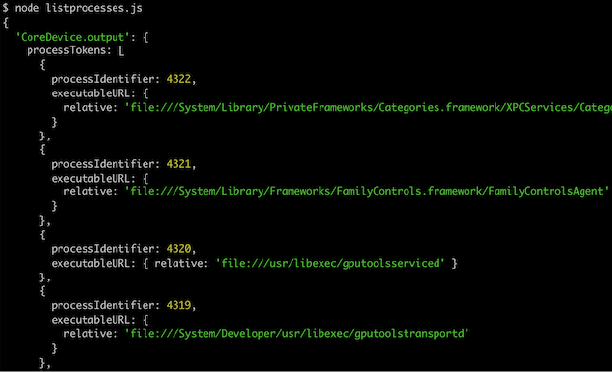Frida, a popular open-source project, is a dynamic instrumentation toolkit that enables developers, security researchers and reverse engineers to inject custom scripts into running processes. It allows users to perform a variety of tasks such as function hooking, API call tracing and runtime manipulation, making it a versatile tool for debugging, reverse engineering and mobile application security testing. Frida supports multiple platforms and introduced iOS 17 support in version 16.3.0. What follows is a behind-the-scenes recounting of how we achieved iOS 17 support (and beyond) in Frida.
Writing software that observes the behavior of other software is fun. Having spent a couple of decades doing this, creating the Frida toolkit in the process, there is one thing that remains constant: each new operating system release may require significant effort to support.
This happens for one of two reasons. The first is that OSes lack one or more of the public APIs that we need, so we end up relying on undocumented internals, and those internals tend to change. The second is that interfacing with a mobile device entails various communication protocols, also typically undocumented, and those also tend to change.
CoreDevice
Starting with iOS 17, Apple moved to a new way of communicating with services on the iDevice side, including its Developer Disk Image (DDI) services. Thisnew way of doing things unifies how Apple software talks to other Apple devices, and is known as CoreDevice. It seems to have originated back when Apple introduced the T2 coprocessor. The Cisco DUO team published some excellent research on this back in 2019.
Like with the T2, the new stack used for iOS 17 also uses RemoteXPC for talking to services. Things are a bit more complex though, because unlike the T2, mobile devices don’t have a persistent connection to macOS, and also have the notion of pairing. Luckily for us, @doronz88 had already done an amazing job reversing and documenting most of what we needed to implement the new protocols, so that saved us a lot of time.
Even so, it was a massive undertaking, but tons of fun — @hsorbo and I had a blast pair-programming on it. Quite a few moving parts are involved, so let’s take a quick walk through them.
It was a massive undertaking, but tons of fun.
With an iDevice plugged in, it exposes a USB CDC-NCM network interface, known as the “private” interface. It also exposes an interface used for tethering, just like it did in the past — except back then it was using a proprietary Apple protocol instead of CDC-NCM.
This is where we hit the first challenges trying to talk to it from a Linux host. First off, the iOS device needs a USB vendor request to mode-switch it into exposing the new interfaces. macOS does this automatically, and we have enhanced Frida to also do this if needed. This is also done by usbmuxd if using a somewhat recent git snapshot, but given that the new CoreDevice support makes usbmux redundant, we figured it would be good to not require it be installed and up-to-date.
The next challenge was that the Linux kernel’s CDC-NCM driver failed to bind to the device. After a bit of debugging we discovered that it was due to the private network interface lacking a status endpoint. The status endpoint is how the driver gets notified about whether a network cable is plugged in. Apple’s tethering network interface has such an endpoint, and it makes sense there — if tethering is disabled it’s just as if the cable is unplugged. But the private interface is always there, so understandably Apple chose not to include a status endpoint for it.
We quickly developed a kernel driver patch to lift the requirement for a status endpoint, and this got it working. Later we realized that we should still require a status endpoint for the tethering interface, so we ended up refining our patch a bit further. We submitted our refined patch, which is now upstream, and will be part of Linux v6.11 once that’s released.
Until then however, and for users on OSes without a compatible NCM driver, we implemented a minimal user-mode driver that Frida now uses when it detects that the kernel doesn’t provide one. We leveraged lwIP to also do Ethernet and IPv6 entirely in user space. The result is that Frida can support CoreDevice on any platform supported by libusb.
Anyway, with the network interface up, the host side uses mDNS to locate the IPv6 address where a RemoteServiceDiscovery (RSD) service is listening. The host connects to it and speaks HTTP/2 with RemoteXPC messages going back and forth. This particular service, RSD, tells the host which services are available on the private interface, the port numbers they’re listening on, and details like the protocol each uses to communicate.
Then, knowing which services are listening on which ports, the host looks up the Tunnel service. This service lets the host establish a tunnel to the device, acting as a VPN to allow it to communicate with the services inside that tunnel. Since setting up such a tunnel requires a pairing relationship between the host and the device, it means that the services inside the tunnel allow the host to do a lot more things than the services outside the tunnel.
The base protocol is the same as with RSD, and after some back and forth involving a pairing parameters binary blob and some cryptography, a pairing relationship is either created or verified. At this point the two endpoints are using encrypted communications, and the host asks the Tunnel service to set up a tunnel listener.
Now, assuming the host asked for the default transport, QUIC, the host goes ahead and connects to it. We should note that the Tunnel service also supports plain TCP. Presumably that is there for older macOS versions that don’t come with a QUIC stack. Another thing worth mentioning is that the Tunnel service provides the host with a keypair, so it uses that as part of the connection setup.
Once connected, the device sends the host some data across a reliable stream. The data starts with an 8 byte magic, “CDTunnel”, followed by a big-endian uint16 that specifies the size of the payload following it. The payload is JSON, and tells the host which IPv6 address the host’s endpoint inside the tunnel has, along with the netmask and MTU. It also tells the host its own IPv6 address inside the tunnel, and the port that the RSD service is listening on.
The host then sets up a TUN device configured as it was just told, and starts feeding it unreliable datagrams as they’re received from the QUIC connection. And for data in the other direction, whenever there’s a new packet from the TUN device, the host feeds that into the QUIC connection.
So at this point the host connects to the RSD endpoint inside the tunnel, and from there it can access all of the services that the device has to offer. The beauty of this new approach is that clients communicating with device-side services don’t have to worry about crypto, nor provide proof of a pairing relationship. They can simply make plaintext TCP connections on the tunnel interface, and QUIC handles the rest transparently.
What’s even cooler is that the host can establish tunnels across both USB and WiFi/a network interface, and because of QUIC’s native support for multipath, the device can seamlessly move between wired and wireless without disrupting connections to services inside the tunnel.
So, once we got all of this implemented we were feeling excited and optimistic. The only part left was to do the platform integrations. And uhh yeah, that’s where things got a lot harder. The part that got us stuck for a while was on macOS, where we realized we had to piggyback on Apple’s existing tunnel. We discovered that the Tunnel service would refuse to talk to us when there’s already a tunnel open, so we couldn’t simply open up a tunnel next to Apple’s.
While we could ask the user to send SIGSTOP to remoted, allowing us to set up our own tunnel, it wouldn’t be a great user experience. Especially since any Apple software wanting to talk to the device then wouldn’t be able to, making Xcode, Console, etc. a lot less useful.
It didn’t take us long to find private APIs that would allow us to determine the device-side address inside Apple’s tunnel, and also create a so-called “assertion” so that the tunnel is kept open for as long as we need it. But the part we couldn’t figure out was how to discover the device-side RSD port inside the tunnel.
We knew that remotepairingd, running as the local user, knows the RSD port, but we couldn’t find a way to get it to tell us what it is. After lots of brainstorming we could only think of impractical solutions:
- Port-scan the device-side address: Potentially slow, and faster implementations would require root for raw socket access.
- Scan remotepairingd’s address space for the device-side tunnel address, and locate the port stored near it: Wouldn’t work with SIP enabled.
- Rely on a device-side frida-server to figure things out for us: This wouldn’t work on jailed iOS, and would be complex and potentially fragile.
- Grab it from the syslog: Could take a while or require a manual user action, and forcing a reconnection by killing a system daemon would result in disruption.
- Give up on using the tunnel, and move to a higher level abstraction, e.g. use MobileDevice.framework whenever we need to open a service: Would require us to possess entitlements. Exactly which depend on the particular service.For example if we’d want to talk to com.apple.coredevice.appservice, we’d need the com.apple.private.CoreDevice.canInstallCustomerContent entitlement. But, trying to give ourselves a com.apple.private.* entitlement just wouldn’t fly, as the system would kill us because only Apple-signed programs can use such entitlements.
This was where we decided to take a break and focus on other things for a while, until we finally found a way: The remoted process has a connection to the RSD service inside the tunnel. We finally arrived at a simple solution, using the same API that Apple’s netstat is using:
The non-macOS side of the story was a lot easier though, as there we are in control and can set up a tunnel ourselves. There was one challenge however: We didn’t want to require elevated privileges to be able to create a tun device. The solution we came up with was to use lwIP to do IPv6 in user-mode. As we had already designed our other building blocks to work with GLib.IOStream, decoupled from sockets and networking, all we had to do was implement an IOStream that uses lwIP to do the heavy lifting. Datagrams from the QUIC connection get fed into an lwIP network interface, and packets emitted by that network interface are fed into the QUIC connection as datagrams.
Once we got all of that working, we also went the extra mile and implemented support for network connectivity, so the USB cable can be unplugged. The pairing step still requires it though, because Apple’s iOS/iPadOS policy is to only allow pairing across the NCM interface. It’s worth mentioning that tvOS allows it, but we didn’t yet get a chance to test that part.
So with all of that working, the only thing left was to enhance frida-server and frida-gadget so they listen on the private interfaces as they appear. This is where we leveraged SystemConfiguration.framework to be notified as the network interfaces come and go.
Jailed iOS 17
With the new CoreDevice infrastructure in place, we also went ahead and restored support for jailed instrumentation on iOS 17. This means we can once again spawn (debuggable) apps on latest iOS, which is 17.5.1 at the time of writing. We also fixed the issue where attach() without spawn() wouldn’t work on recent iOS versions.
iOS 18 betas
We also went ahead and explored the latest betas, and adapted Frida to the new changes in Apple’s dynamic linker. So as of the latest Frida 16.4, there is now also support for iOS 18 and macOS Sequoia. Exciting times ahead!
Device.open_service() and the Service API
Given that Frida needs to speak quite a few protocols to interact with Apple’s device-side services, and our products also need other such services, this presents a challenge. We could speak these protocols ourselves, e.g. after using the Device.open_channel() API to open an IOStream to a specific service. But this means we’d have to duplicate the effort of implementing and maintaining the protocol stacks, and for protocols such as DTX we’d be wasting time establishing a connection that Frida already established for its own needs.
One possible solution would be to make these service clients public API and expose them in Frida’s language bindings. We would also have to implement clients for all of the Apple services that our products want to talk to. That’s quite a few, and would result in the Frida API becoming massive. It would also make Frida a kitchen sink of sorts, and that’s clearly not a direction we want to be heading in.
After thinking about this for a while, it occurred to me that we could provide a generic abstraction that lets the application talk to any service that they want. So @hsorbo and I filled up our coffee cups and got to work. We’re quite happy with how it turned out.
Here’s how easy it is to talk to a RemoteXPC service from Python:
And the same example, from Node.js:
Which results in:

So now that we’ve looked at the new open_service() API being used from Python and Node.js, we should probably mention that it is (almost) just as easy to use this API from C:
(Error-handling and cleanup omitted for brevity.)
The string passed into open_service() is the address where the service can be reached, which starts with a protocol identifier followed by colon and the service name. This returns an implementation of the Service interface, which looks like this:
(Synchronous methods omitted for brevity.)
Here, request() is what you call with a Variant, which can be “anything”, a dictionary, array, string, etc. It is up to the specific protocol what is expected. Our language bindings take care of turning a native value, for example a dict in case of Python, into a Variant. Once request() returns, it gives you a Variant with the response. This is then turned into a native value, e.g. a Python dict.
For protocols that support notifications, the message signal is emitted whenever a notification is received. Since Frida’s APIs also offer synchronous versions of all methods, allowing them to be called from an arbitrary thread, this presents a challenge: If a message is emitted as soon as you open a specific service, you might be too late in registering the handler. This is where activate() comes into play. The service object starts out in the inactive state, allowing signal handlers to be registered. Then, once you’re ready for events, you can either call activate(), or make a request(), which moves the service object into active state.
Then, later, to shut things down, cancel() may be called. The close signal is useful to know when a Service is no longer available, e.g. because the device was unplugged or you sent it an invalid message causing it to close the connection.
It’s also easy to talk to DTX services, which is RemoteXPC’s predecessor, still used by many DDI services.
For example, to grab a screenshot:
But there’s more. We also support talking to old-style plist services, where you send a plist as the request, and receive one or more plist responses:
As you might have already guessed, this example puts the connected iDevice to sleep.
iOS 17 and beyond
NowSecure contributes significantly to open-source community projects such as Frida and Radare and industry standards from the OWASP Mobile Application Security Project (MAS). NowSecure Platform automated mobile application security testing software uses Frida to perform fast, deep security and privacy analysis of mobile apps at scale. Frida support for iOS 17 powers NowSecure Platform risk assessments of the latest iOS mobile apps. Contact us for a demo of NowSecure Platform.





